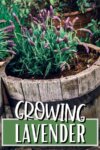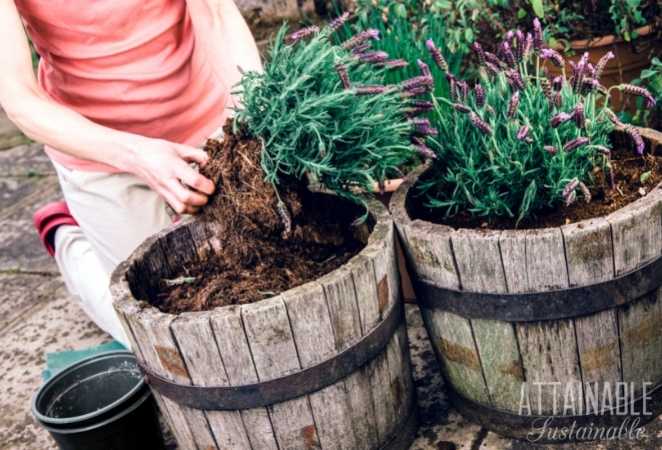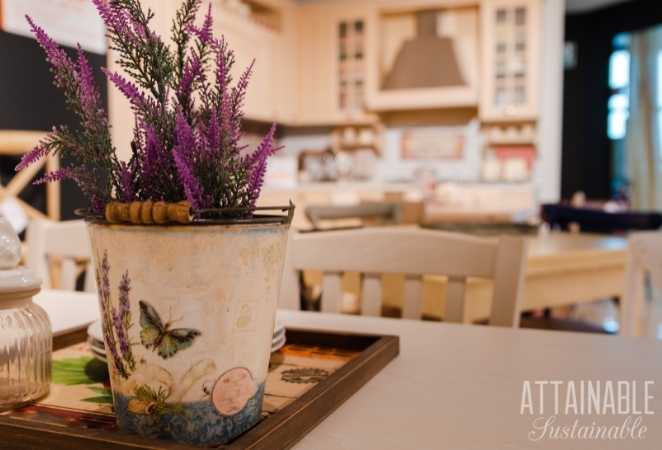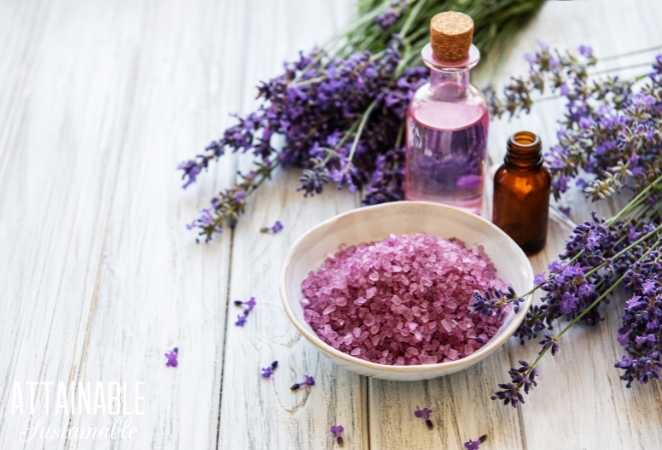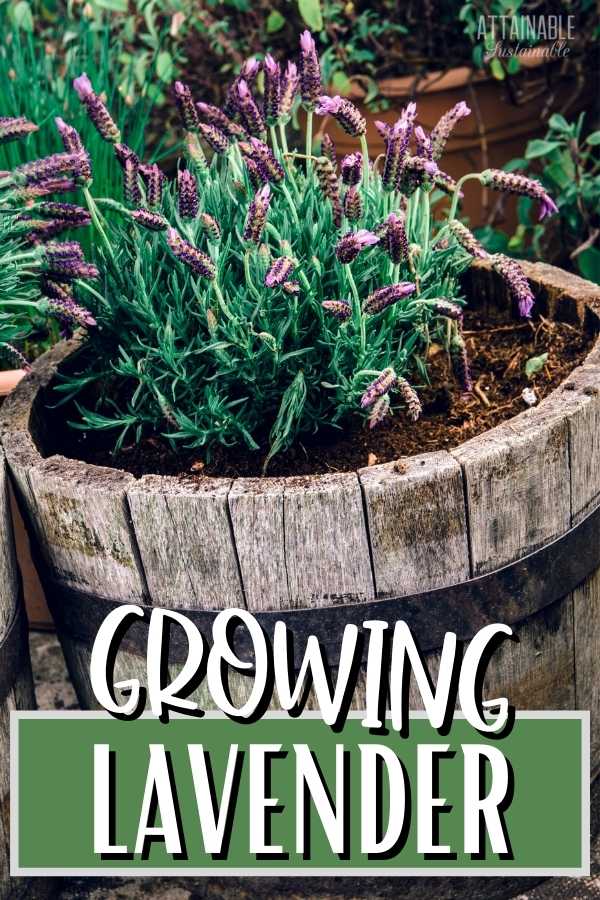Lavender is a long-blooming, low-maintenance shrubby perennial that has a long history as a medicinal and culinary herb. Its flowers are a fragrant favorite of bees and other pollinators. It is easy to grow with lovely scented leaves and spikes of purple, white, or pink flowers that show up in early summer and last until fall.
To bring more pollinators to your garden, you might want to also grow basil.
Contributed by Jodi Torpey, author and Master Gardener.
All About Lavender
Lavender is a classic cottage garden plant with its upright and rounded form and silver gray-green needle-like leaves. Because of its versatility, lavender looks at home in herb gardens, ornamental flower beds or wherever perennial plants grow.
One great use is to plant lavender along a pathway where its fragrant flowers will be on display (and attract pollinators). Other uses for lavender in the landscape include as an edging or border plant around ornamental flower beds.
There are different forms of lavender, but most plants form in tidy mounds and grow 1-3 feet tall and 2-3 feet wide. These plants take average, well-draining garden soil and can be drought-tolerant once established in the garden. Lavender is also a mosquito repelling plant for natural pest control in your yard.
Grow Some Greens!
Ready to grow fresh greens, no matter WHERE you live? Sign up for my
FREE quick-start guide and start growing some of your own food!
New to gardening? Limited on space? The 5-Gallon Garden gives you the skills you need to grow food in the space you have. Get started with your garden today!
Lavender varieties to consider
Lavandula angustifolia or English lavender is the most cold-hardy of the lavenders and features gray-green to silvery leaves. The lavender-blue flower spikes form on plants that grow 18-24 inches.
- angustifolia ‘Alba’ is a rather unusual lavender because it grows white flowers on mounded plants.
- angustifolia ‘Hidcote’ is a familiar lavender for its deep, dark purple flowers that show up on compact plants; grows to about 15 inches.
- angustifolia ‘Munstead’ is a dwarf form of lavender (12 inches) that blooms earlier in the season with deep lavender-blue flowers.
How to plant lavender
Lavender plants can be grown from seeds, plants purchased at a garden center or by taking cuttings to propagate.
Starting lavender from seeds requires patience because it takes time for seeds to germinate and grow to a transplantable size. If growing from seeds, be sure to purchase them from a reliable source so you know the variety you’ll be planting.
Plan on giving seeds 2 to 6 weeks to germinate and about 4 or more months for plants to be ready to transplant to the garden.
Because of the length of time to grow lavender from seeds, most lavender lovers prefer to buy plants and then propagate lavender from that plant’s cuttings.
For cold-weather regions, wait to plant lavender until after danger of frost has passed. Warmer regions, without freezing temperatures, can plant when it’s the best perennial planting time for your region.
Lavender prefers a dry to moderately moist soil, so avoid planting near watered sod, next to a drain downspout, by a pond or anywhere that water has a tendency to pool. Lavender needs sunny and dry conditions to grow well.
Space according to the variety’s planting instructions to give plants room to grow and air to circulate. Dig planting holes slightly larger than the root ball and place in the ground at the same level as in the container.
Requirements for Growing Lavender
Light requirements
Lavender is a plant that appreciates full sun and a hot spot, so locate the sunniest area in your landscape. Too much shade will cause lavender plants to stretch out and produce fewer flowers over time. Shade also makes it difficult for lavender to overwinter successfully.
Soil requirements
Lavender grows best in a well-draining, alkaline soil because wet roots tend to rot. Plant lavender in dry, slightly rocky, sandy or organic soils. Avoid planting in clay soils or in rich well-amended soils. Good soil drainage is key, especially if you want your lavender plants to overwinter successfully and start regrowing in spring.
Avoid wood bark mulches and use pea gravel as a mulch instead. Rock mulch allows water to absorb into soil and drain quickly to keep roots healthy.
Water and fertilizer requirements
Let the soil dry between waterings for this drought-tolerant plant; no more than ½ inch of water each week, even in the hottest part of summer. However, lavender will dry out and die in times of prolonged drought. Be sure to keep water off of the leaves.
Avoid adding fertilizers that encourages extra growth that produces floppy stems.
How to Prune Lavender Plants
Lavender plants need to be pruned on a regular basis to keep plants healthy and to manage growth. In general, when plants reach about 18 inches tall, use sharp pruners to cut it back to 9 to 12 inches tall.
In spring pruning is done to remove any dead tips and to encourage more new growth on the lavender’s lowest branches. Remove any dead branches back to where the branches are green and living. Sometimes you may have to prune the branch all the way to the ground.
In summer, prune lavender after removing any flower spikes by taking a few inches of top growth off the plant. This pruning helps keep the plant’s shape and encourages new growth.
Potential Lavender Problems
Lavender attracts few pests, but can suffer from soil-borne and leaf fungus problems. In humid areas, leaf spot may occur. Prevent potential problems by ensuring soil is quick-draining and that plants are spaced far enough apart to allow air to circulate.
After plants start to grow again in spring, prune out any dead branches or stems and trim to reshape each plant. If plants are too leggy or have stopped their vigorous blooming, cut them back to encourage new growth and more flowers.
Growing lavender in pots
Lavender is hardy in to Zone 5 when grown in containers. For cold-weather regions, lavender needs protection to overwinter in containers.
To plant a container of lavender, use a large pot (with an opening of at least 12 inches) and select a porous potting mix. Keep container in a sunny spot and water only when the soil has dried.
To overwinter containers in a cold climate, move them into a protected space, such as an unheated porch, and water containers once every two months to keep plants from drying out completely.
Harvesting and Using Lavender
For lavender drying, harvest the flowers just before they start to open and when flowers begin to swell, but are still tight to the stem. Dried lavender can be used in these easy lavender bath fizzies, homemade soap bars, DIY salt scrub, scented pillows and herbal sachets, or dried flower arrangements.
To harvest lavender for its fragrance, plan to cut the long flower spikes early in the morning when the flowers are freshest and individual flowers are fully open. Use sharp pruners or scissors to cut the entire flower spikes from the plant.
In the kitchen, lavender flowers can be used in baking sweets, as an ingredient in the spice blend called Herbs de Provence or for flavoring jams, jellies, and ice cream.
Propagating Lavender
Lavender is a perennial plant, but these plants don’t live forever. Some experts estimate that healthy, well-tended lavenders can last anywhere from 5-10 years. A good practice for growing lavender is to take cuttings on a regular basis to grow new plants to replace the older ones.
Lavender stem cuttings are similar to other perennial plant cuttings, but wait for the third season to take a cutting to propagate.
Here are the basics of propagating lavender plants with cuttings:
Look for plants that are almost ready to flower and take cuttings in the morning when plants are fresh and the soft tips are still pliable. Use sharp pruners and cut a stem about 2-3 inches long and place in a sterile soil medium, not potting soil.
Plant cuttings in clean cell-pack germination trays like those used to start bedding plants. Keep the sterile soil mix warm and damp; place in bright sunlight until cuttings start to root or for about a month.
When cuttings have grown roots, transplant each into a 4-inch flowerpot to continue growing for another month or more before transplanting into the garden.
